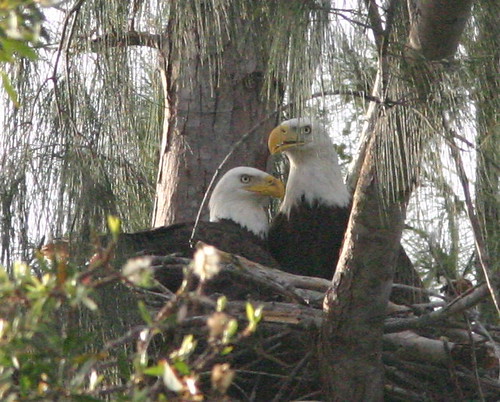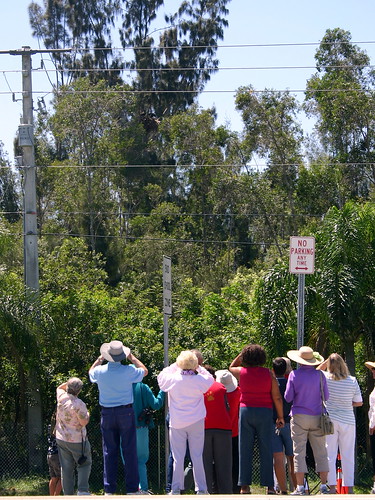Eagle pair at nest in December, 2008, two days before first egg was laid:
When a pair of Bald Eagles decided to set up housekeeping in a tall Australian Pine just off busy Pines Boulevard in Pembroke Pines, Florida, they initiated an interesting chain of events. They were first “discovered” in March of 2008 by Kelly Smith, a local Middle School science teacher, who saw adults and a nearly full grown eaglet in the nest. For a year or two before that, several local residents (and even a bus driver who regularly ran the Pines Boulevard route) had seen eagles roosting and carrying nest materials and prey in that general location.
All known Bald Eagle nests in Florida are registered by the Fish & Wildlife Conservation Commission and their locations are pinpointed on the FWC Web site, but the majority of South Florida residents are unaware that, among the lower 48 states, Florida is second only to Minnesota in the number of active eagle nests.
A few birders and local residents kept an eye on the nest site, which was in full view only about 200 feet from the roadway. In November of 2008, the pair of eagles started bringing sticks to the nest site. The female settled down to incubate their eggs in mid-December. Ms. Smith’s science students engaged in a study of whether changes in traffic density on Pines Boulevard had any adverse effect upon the eagles’ behavior. The presence of even one or two eagle watchers attracted curious onlookers, some of whom became ardent observers as the pair exchanged duties sitting on the eggs.
In mid-January, 2009, just as the eggs were hatching, concerns about planned construction near the Pembroke Pines nest site ignited public interest. Someone alerted the press, and all the local TV network affiliates and both daily newspapers covered the story. The two little chicks began peering over the edge of the nest in early February, geeted by crowds of onlookers. During the next several weeks, especially on weekends, as many as 50 autos and over 100 people showed up in the grassy area at the edge of the highway, hoping to see the marvelous sight.
On weekdays, the number of watchers was usually much smaller. The optimal viewing point was dangerously close to the roadway:
Happily, the 27 acre wooded area where the eagles took up housekeeping is located on land owned by the City of Pembroke Pines, acquired in a land swap a few years back. Although zoned for residential use, the City had no immediate plans to develop or sell the property. Responding to complaints that over-zealous photographers and birdwatchers had entered the property for even better looks, the city erected a temporary chain-link fence along the highway right of way, which includes about a 50 foot grassy swale. Parking was prohibited along the entire block in front of the nest, and pylons discouraged the crowds from approaching the fenced area. This limited observers to about a 30 foot wide swath of the shoulder of the busy road.
Visitors often returned several times to watch the progression of the chicks. Photographers sometimes had to compete for unobstructed views, as limbs from the neighboring trees grew tall in front of the nest. People brought their small children and dogs, whose antics and noise was perceived as a possible threat to the eagles. Worse, spectators sometimes stood very close to the edge of the payment, and even ventured into the traffic lanes. There were no provisions for safe off-road parking, and signs restricting parking on the side of the road near the nest were often ignored, posing a hazard to motorists on this 45 MPH highway.
The nest is clearly visible from the road:
Several local citizens organized into an informal eagle nest watching
group. Their presence added a measure of safety for the birds, as the
volunteers were alert to anything that might disturb or injure the
birds or observers. They discouraged illegal parking, asked parents to
control unruly children, admonished trespassersd, and called local
police when vehicles obstructed the roadway. The observers were there
to alert the Fish and Wildlife Conservation Commission when the eaglets
made their first precarious flights and fell to the ground.
Out of concern for visitor safety, the Florida Department of Transportation (FDOT) plans to construct a sidewalk and is considering ways to provide a safe viewing area that separates viewers from the traffic. However, the planning horizon for such measures is rather extended. Specification must be drawn up, approvals must be obtained, contracts negotiated, and any improvements will not be completed until June 2011. In the meantime, for the next two breeding seasons, observers will be restricted to the opposite side of the highway, which has a sidewalk.
The eagle pair has recently returned to the nest tree. They have been seen bringing in sticks, refurbishing the nest, and even carrying in prey and consuming it on the nest. If they follow the pattern established last year, eggs will be laid around mid-December, and eaglets will hatch 35 days later. However, there will be no way to accommodate crowds of onlookers and vehicles. For the next two years, visits to the nest will necessarily be curtailed. Violators may expect to be ticketed and fined.
Several eagle watchers have expressed interest in having a nest cam installed. Such a camera would require funding and acquisition of dedicated bandwidth. We understand that electrical power may be available from a box only about 150 feet from the nest. If funding were obtained and local permissions were granted, a formal application must be processed. FWC requires application for an eagle nest cam to be made 90 days before intended installation, if it is placed within the 330 foot buffer zone around the nest.
Osprey Cam at St. Andrews Links in Dunedin, Florida (Click here for Live View):

Of course, a camera view is no substitute for the real thing, but it can provide valuable information about the welfare and habits of the birds. Interestingly, this Osprey cam has just begun operating at a nest in Pinellas County. You might wish to check out the Osprey cam Web site at this link
While FDOT regards the new restrictions as the only safe and practical response to the traffic hazards, they will be an added inconvenience for those who come to the nest site to see the eagles. Our hope that the public will have a safe vantage point during this and the next eagle nesting season is fading fast. As much as we have enjoyed the close views from the south side of Pines Boulevard, and so many have accepted the risks of standing next to a busy highway to obtain those views, we have no inherent right to them. We do not “own” the eagles, and public safety cannot take a back seat to our desire to get close to them.
If sufficient resources, such as corporate sponsorship might be obtained, there is the possibility that a remote camera could be mounted with a clear view of the nest. Connected to the Internet, such an “Eagle Cam” would allow everyone to “own” great views of the family life of these great birds. The Dunedin Links Osprey Cam provides us with an excellent example of the educational value of a nest camera. I invite you to provide us with suggestions as to methods and possible resources.















